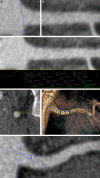Retrospective morphometric study of the suitability of renal arteries for renal denervation according to the Symplicity HTN2 trial criteria
- PMID: 26729385
- PMCID: PMC4716171
- DOI: 10.1136/bmjopen-2015-009351
Retrospective morphometric study of the suitability of renal arteries for renal denervation according to the Symplicity HTN2 trial criteria
Abstract
Objective: The aim of this study was to describe the renal arteries of humans in vivo, as precisely as possible, and to formulate an expected value for the exclusion of renal denervation due to the anatomical situation based on the criteria of the Symplicity HTN trials.
Design and setting: In a retrospective cohort study, the renal arteries of 126 patients (57 women, 69 men, mean age 60 ± 17.2 years (CI 57.7 to 63.6)) were segmented semiautomatically from high-contrast CT angiographies.
Results: Among the 300 renal arteries, there were three arteries with fibromuscular dysplasia and one with ostial renal artery stenosis. The first left renal artery was shorter than the right (34 ± 11.4 mm (CI 32 to 36) vs 45.9 ± 15 mm (CI 43.2 to 48.6); p<0.0001), but had a slightly larger diameter (5.2 ± 1.4 mm (CI 4.9 to 5.4) vs 4.9 ± 1.2 mm (CI 4.6 to 5.1); p>0.05). The first left renal arteries were 1.1 ± 0.4 mm (CI 0.9 to 1.3), and the first right renal arteries were 0.3 ± 0.6 mm (CI 0.1 to 0.5) thinner in women than in men (p<0.05). Ostial funnels were up to 14 mm long. The cross-sections were elliptical, more pronounced on the right side (p<0.05). In 23 cases (18.3%), the main artery was shorter than 2 cm; in 43 cases (34.1%), the diameter was not >4 mm. Some 46% of the patients, or 58.7% when variants and diseases were taken into consideration, were theoretically not suitable for denervation.
Conclusions: Based on these precise measurements, the anatomical situation as a reason for ruling out denervation appears to be significantly more common than previously suspected. Since this can be the cause of the failure of treatment in some cases, further development of catheters or direct percutaneous approaches may improve success rates.
Keywords: RADIOLOGY & IMAGING.
Published by the BMJ Publishing Group Limited. For permission to use (where not already granted under a licence) please go to http://www.bmj.com/company/products-services/rights-and-licensing/
Figures



Similar articles
-
Impact of renal denervation on 24-hour ambulatory blood pressure: results from SYMPLICITY HTN-3.J Am Coll Cardiol. 2014 Sep 16;64(11):1071-8. doi: 10.1016/j.jacc.2014.05.012. Epub 2014 May 20. J Am Coll Cardiol. 2014. PMID: 24858423 Clinical Trial.
-
Renal artery anatomy affects the blood pressure response to renal denervation in patients with resistant hypertension.Int J Cardiol. 2016 Jan 1;202:388-93. doi: 10.1016/j.ijcard.2015.09.015. Epub 2015 Sep 21. Int J Cardiol. 2016. PMID: 26432488
-
Anatomic Patterns of Renal Arterial Sympathetic Innervation: New Aspects for Renal Denervation.J Interv Cardiol. 2016 Dec;29(6):594-600. doi: 10.1111/joic.12343. Epub 2016 Sep 29. J Interv Cardiol. 2016. PMID: 27687514
-
Percutaneous renal sympathetic denervation: 2013 and beyond.Can J Cardiol. 2014 Jan;30(1):64-74. doi: 10.1016/j.cjca.2013.11.003. Epub 2013 Nov 7. Can J Cardiol. 2014. PMID: 24365191 Review.
-
Sympathetic renal denervation: hypertension beyond SYMPLICITY.Cardiovasc Revasc Med. 2013 Jul-Aug;14(4):229-35. doi: 10.1016/j.carrev.2013.02.004. Cardiovasc Revasc Med. 2013. PMID: 23928314 Review.
Cited by
-
Anatomical variation of the aorta in the West of Scotland - A population with high cardiovascular disease burden. Implications for stent design and deployment.J Anat. 2023 Jan;242(1):112-120. doi: 10.1111/joa.13652. Epub 2022 Mar 17. J Anat. 2023. PMID: 35301720 Free PMC article.
-
Analysis of renal artery morphometery in adults: A study conducted by using Multidetector computed Tomography Angiography.Pak J Med Sci. 2017 Jul-Aug;33(4):943-947. doi: 10.12669/pjms.334.13063. Pak J Med Sci. 2017. PMID: 29067070 Free PMC article.
-
Renal artery anatomy assessed by quantitative analysis of selective renal angiography in 1,000 patients with hypertension.EuroIntervention. 2018 May 20;14(1):121-128. doi: 10.4244/EIJ-D-18-00112. EuroIntervention. 2018. PMID: 29633939 Free PMC article.
-
The interdependent hemodynamic influence between abdominal aortic aneurysm and renal artery stenosis.Sci Rep. 2024 Dec 30;14(1):31986. doi: 10.1038/s41598-024-83622-x. Sci Rep. 2024. PMID: 39738423 Free PMC article.
References
-
- Björk S, Sannerstedt R, Falkheden T et al. . The effect of active drug treatment in severe hypertensive disease: an analysis of survival rates in 381 cases on combined treatment with various hypotensive agents. Acta Med Scand 1961;169:673–89. 10.1111/j.0954-6820.1961.tb07878.x - DOI
MeSH terms
LinkOut - more resources
Full Text Sources
Other Literature Sources
Medical
